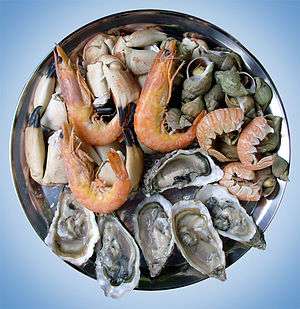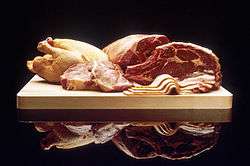Perch
| Perches | |
|---|---|
 | |
| Yellow perch (Perca flavescens) | |
| Scientific classification | |
| Kingdom: | Animalia |
| Phylum: | Chordata |
| Superclass: | Osteichthyes |
| Class: | Actinopterygii |
| Subclass: | Neopterygii |
| Infraclass: | Teleostei |
| Order: | Perciformes |
| Family: | Percidae |
| Genus: | Perca Linnaeus, 1758 |
| Type species | |
| Perca fluviatilis Linnaeus, 1758 | |
| Species | |
| |
Perch is a common name for fish of the genus Perca, freshwater gamefish belonging to the family Percidae. The perch, of which there are three species in different geographical areas, lend their name to a large order of vertebrates: the Perciformes, from the Greek perke, simply meaning perch, and the Latin forma meaning shape. Many species of freshwater gamefish more or less resemble perch, but belong to different genera. In fact, the exclusively saltwater dwelling red drum is often referred to as a red perch, though by definition perch are freshwater fish. Though many fish are referred to as perch as a common name, to be considered a true perch, the fish must be of the family Percidae.
The type species for this genus is the European perch, Perca fluviatilis.
Species
Most authorities recognize three species within the perch genus:
- The European perch (Perca fluviatilis) is found in Europe and Asia. This species is typically greenish in color with dark vertical bars on its sides with a red or orange coloring in the tips of its fins. The European perch has been successfully introduced in New Zealand and Australia, where it is known as the redfin perch or English perch. In Australia, larger specimens have been bred, but the species rarely grows larger than about six pounds.
- The Balkhash perch (Perca schrenkii) is found in Kazakhstan, (in Lake Balkhash and Lake Alakol), Uzbekistan, and China. It is very similar to the European perch, and grows to a comparable size.
- The yellow perch (Perca flavescens), smaller and paler than the European perch, is found in the United States and Canada. In northern areas, it is sometimes referred to as the lake perch. This species is prized for its food quality and has often been raised in hatcheries and introduced into areas in which it is not native. Yellow perch are almost identical in appearance to European perch, but have a more yellow coloring. These fish typically only reach a size of about 15 in and 2.2 lb (1 kg).
Anatomy
The general body type of a perch is somewhat long and rounded. True perch have "rough" or ctenoid scales. On the anterior side of the head are the maxilla and lower mandible for the mouth, a pair of nostrils, and two lidless eyes. On the posterior sides are the opercula, which protect the gills, and the lateral line system, which is sensitive to vibrations in the water. They have paired pectoral and pelvic fins, and two dorsal fins, the first one spiny and the second soft. These two fins can be separate or joined.
Habitats
Perch are carnivorous fish most commonly found in small ponds, lakes, streams, or rivers. These fish feed on smaller fish, shellfish, or insect larvae, but can be caught with nearly any bait. They commonly spawn during the spring, when the females lay strings of eggs in covered areas such as near branches or underwater plants. Perch have a wide distribution throughout the world, and are very plentiful in the Great Lakes, especially Lake Erie.
Fishing
Perch are popular sport fish species. They are known to put up a fight, and to be good eating. They can be caught with a variety of methods, including float fishing, lure fishing and legering. The best way is to use a small hook and cast into the weeds just before the drop off. When fishing with bait, the angler will want to have a disgorger; perch are notorious for swallowing the hook, and will need aid of a disgorger or forceps for unhooking. In many parts of the world, they are also a favourite species among ice fishermen. They will take a variety of baits, including minnows, worms, maggots, goldfish, pieces of raw bacon, and softshell crayfish, but seem to prefer small fish, lobworms, red maggots, and lures. Fly fishing for perch using patterns that imitate small fry or invertebrates can be successful. The record weight for this fish in Britain is 6 lb 3 oz (2.81 kg), and in America 6 lb 4 oz (2.83 kg).
Perch grow to around 5 lb (2.3 kg) or more, but the most common fish to be caught are around 1 lb (0.45 kg) or less, and anything over 2 lb (0.91 kg) is considered a prize catch.
Perch have often formed a critical part of the total weight caught by an angler during a competition. In 2016 it was recorded that angler Ross Winfield failed to weigh a perch during a competition that cost him a top 5 place (often called 'framing' on the UK match fishing circuit). Unfortunately, he later found the perch in his keep net.
In the aquarium
As the Perch grow larger they may become too large for the aquarium or pond. They may also eat any smaller fish in the aquarium or pond which may be an issue to the owner of the fish. This fish is more reliable in a dam or larger water source such as a large pond with more freedom to live and breed. However, there are other breeds of perch such as Golden Perch or the Southern Pigmy Perch which are much smaller breeds and will eat general fish foods rather the other fish with them.
See also
- For other perch not in the Perca genus, see Perch (disambiguation).

